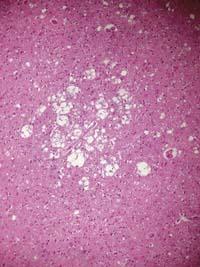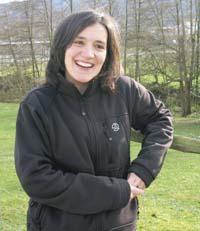Lethal family insomnia

Lethal family insomnia is closely related to mad cow disease. Behind them are infectious proteins called prions, both included in the group of transmissible spontaneous encephalopathies.
In fact, the emergence in 1996 of the new variant of Creutzfeldt-Jakob disease, derived from bovine spongiform encephalopathy, launched a surveillance network of prionic diseases. Thanks to this, there has been a thorough follow-up of these diseases and, in the case of family lethal insomnia, of the nearly 100 known cases, 40 are in Spain, 17 of them in the Autonomous Community of the Basque Country.
The diversity of cases existing in the ACBC is due to the founding effect. The disease is caused by mutation of the PRNP gene encoding a prion (D178N mutations). This mutation was to be initially individual or minority and has multiplied when transmitted to descendants. This is the founding effect that Ana Belén Rodríguez Martínez has shown in her thesis at the UPV.
The thesis was directed by Marian Martínez Pancorbo, Professor of Cell Biology of the Faculty of Pharmacy of the UPV/EHU and Juan José Zarranza, Head of the Neurology Service of the Cruces Hospital and Professor of Neurology of the Faculty of Medicine and Dentistry of the UPV. The latter is, in addition, the coordinator of the network of surveillance of prionic diseases of the CAPV.
"If in the hospital of Donostia they suspect a case, they pass the notice to Dr. Zarranz," Rodríguez explains. Subsequently, autopsies are performed in Txagorritxu and some samples are sent to Neiker-Tecnalia for protein identification. Doctor Rodríguez is currently working there.

Several symptoms of multiple symptoms
"The disease is called this way because the first case described had this symptom," explains Rodríguez. It was first described in 1986 by Italian neurologist Elio Lugares, when a patient suffering from insomnia was consulted. Places was an expert in alterations of sleep, but that rare insomnia did not find any explanation and the somnifers did not work. It did not associate Creutzfeldt-Jakob until the realization of the autopsy of the patient, since the cerebral alterations were similar to those that occur in this disease.
In this case, insomnia was the main symptom, but it is not always so. "Sometimes the sick sleep, but, however, they feel tired during the day, and the neurologists see their sleep altered and do not rest," says Rodríguez. There are also memory problems, coordination when walking, speaking, etc. Also hallucinations, which finally, by dementia, enter into a coma.
Symptomatologies can be very different. "There are two brothers: one developed family insomnia and the other developed Creutzfeldt-Jakob disease; and both had the same mutation," says Rodriguez.
The D178N mutation produces a change in the configuration of the protein encoded by the PRNP gene. This protein (prion) is not degradable and accumulates in the central nervous system. Finally, congestion causes the death of neurons. The mutation is dominant, so there is a 50% chance to move to the following. And those who have mutation have a very high chance of developing the disease.
Founding Effect Founder

"Being so rare the mutation -- 100 cases around the world -- most likely the Basque cases were related," Rodríguez said. To demonstrate this, some DNA sequences (microsatellites) very close to the PRNP gene were analyzed. If the cases were related, these sequences would be the same or very similar. And so they saw him. A remarkable founding effect.
The next step was to conduct a genealogical study to find a common ancestor. Rodríguez could not reach the common ancestor, but after passing through diocesan archives, he related most cases and reached up to 1630. However, it considers that all cases of the ACBC have the same anchor: "If not, it would mean that the mutation is easier and then there would be more than 100 cases in the world."
Another thing is to know where the true origin of the mutation is and how many times it has appeared in other parts of the world. In another part of the study, some cases of Spain, Italy and Germany were analyzed. DNA analysis has revealed that German cases are related to those of the Italian region of Veneto, as well as to those of Italian Tuscany and some Spanish. The cases of ACBC, however, are independent. "It's hard to say," says Rodríguez, "but I would say there are three branches derived from three mutation events."
Buletina
Bidali zure helbide elektronikoa eta jaso asteroko buletina zure sarrera-ontzian











